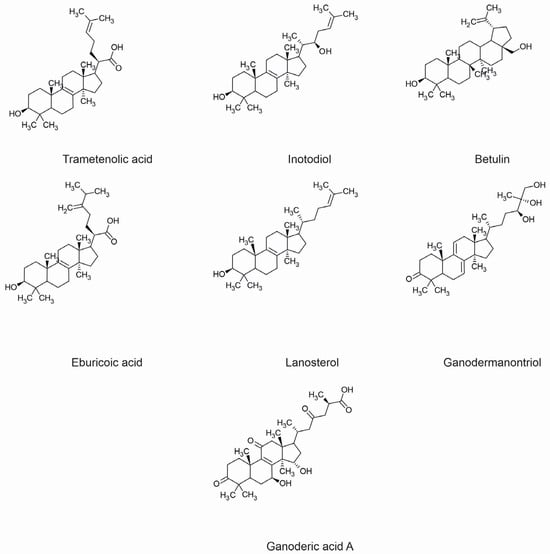
| Version | Summary | Created by | Modification | Content Size | Created at | Operation |
|---|---|---|---|---|---|---|
| 1 | Katarzyna Sułkowska-Ziaja | -- | 1190 | 2024-03-18 22:23:27 | | | |
| 2 | Dean Liu | Meta information modification | 1190 | 2024-04-15 07:19:44 | | |
Video Upload Options
Terpenes and their derivatives comprise a diverse group of natural compounds with versatile medicinal properties. This article elucidates the general characteristics of fungal terpenes and terpenoids, encompassing their structure and biogenesis. The focal point of this work involves a comprehensive overview of these compounds, highlighting their therapeutic properties, mechanisms of action, and potential applications in treating specific skin conditions. Numerous isolated terpenes and terpenoids have demonstrated noteworthy anti-inflammatory and anti-microbial effects, rivalling or surpassing the efficacy of currently employed treatments for inflammation or skin infections. Due to their well-documented antioxidant and anti-cancer attributes, these compounds exhibit promise in both preventing and treating skin cancer. Terpenes and terpenoids sourced from fungi display the capability to inhibit tyrosinase, suggesting potential applications in addressing skin pigmentation disorders and cancers linked to melanogenesis dysfunctions.
1. Introduction
2. General Characteristics and Occurrence of Terpenes and Terpenoids
3. Biogenesis
4. Structure and Chemical Classification of Terpenes and Terpenoids
5. Pharmacological Activities in Skin Disorders

References
- Chen, H.P.; Liu, J.K. Secondary metabolites from higher fungi. In Progress in the Chemistry of Organic Natural Products; Springer: Cham, Switzerland, 2017; Volume 106, pp. 1–201.
- Wang, S.; Bao, L.; Zhao, F.; Wang, Q.; Li, S.; Ren, J.; Li, L.; Wen, H.; Guo, L.; Liu, H. Isolation, identification, and bioactivity of monoterpenoids and sesquiterpenoids from the mycelia of edible mushroom Pleurotus cornucopiae. J. Agric. Food Chem. 2013, 61, 5122–5129.
- Ivanowa, T.S.; Krupodorova, T.A.; Barshteyn, V.Y.; Artamonova, A.B.; Shlyakhovenko, V.A. Anticancer substances of mushroom origin. Exp. Oncol. 2014, 36, 58–66.
- Gallo, R.L. Human skin is the largest epithelial surface for interaction with microbes. J. Investig. Dermatol. 2017, 137, 1213–1214.
- Yuan, H.; Ma, Q.; Ye, L.; Piao, G. The traditional medicine and modern medicine from natural products. Molecules 2016, 21, 559.
- Fraga, B.M. Natural sesquiterpenoids. Nat. Prod. Rep. 2011, 28, 1580–1610.
- Hu, J.Y.; Yang, T.; Liu, J.; Xiao, L.; Lin, L.B.; Li, Y.C.; Ge, M.Y.; Ji, P.; Xiao, J.; Wang, X.L. Two new sesquiterpenoids from plant endophytic fungus Flammulina velutipes. J. Asian Nat. Prod. Res. 2023, 25, 156–162.
- Su, H.G.; Peng, X.R.; Shi, Q.Q.; Huang, Y.J.; Zhou, L.; Qiu, M.H. Lanostane triterpenoids with anti-inflammatory activities from Ganoderma lucidum. Phytochemistry 2020, 173, 112256.
- Zhao, S.; Gao, Q.; Rong, C.; Wang, S.; Zhao, Z.; Liu, Y.; Xu, J. Immunomodulatory effects of edible and medicinal mushrooms and their bioactive immunoregulatory products. J. Fungi 2020, 6, 269.
- Erbiai, E.H.; Pinto da Silva, L.; Saidi, R.; Lamrani, Z.; Esteves da Silva, J.C.G.; Maouni, A. Chemical composition, bioactive compounds, and antioxidant activity of two wild edible mushrooms Armillaria mellea and Macrolepiota procera from two countries (Morocco and Portugal). Biomolecules 2021, 11, 575.
- Park, J.; Nguyen, T.M.N.; Park, H.A.; Nguyen, M.T.T.; Lee, N.Y.; Ban, S.Y.; Park, K.B.; Lee, C.K.; Kim, J.; Park, J.T. Protective effects of lanostane triterpenoids from Chaga mushroom in human keratinocytes, HaCaT cells, against inflammatory and oxidative stresses. Int. J. Mol. Sci. 2023, 24, 12803.
- Harhaji, L.; Mijatović, S.; Maksimović-Ivanić, D.; Stojanović, I.; Momčilović, M.; Maksimović, V.; Tufegdžić, S.; Marjanović, Ž.; Mostarica-Stojković, M.; Vučinić, Ž.; et al. Anti-tumor effect of Coriolus versicolor methanol extract against mouse B16 melanoma cells: In vitro and in vivo study. Food Chem. Toxicol. 2008, 46, 1825–1833.
- Paduch, R.; Kandefer-Szerszeń, M.; Trytek, M.; Fiedurek, J. Terpenes: Substances useful in human healthcare. Arch. Immunol. Ther. Exp. 2007, 55, 315–327.
- Jaeger, R.; Cuny, E. Terpenoids with special pharmacological significance: A review. Nat. Prod. Commun. 2016, 11, 1373–1390.
- Breitmaier, E. Terpenes: Flavors, Fragrances, Pharmaca, Pheromones; Wiley-VCH Verlag GmbH & Co KGaA: Weinheim, Germany, 2006; p. 214. ISBN 9783527317868.
- Cox-Georgian, D.; Ramadoss, N.; Dona, C.; Basu, C. Therapeutic and medicinal uses of terpenes. In Medicinal Plants; Springer: Cham, Switzerland, 2019; pp. 333–359.
- Tetali, S.D. Terpenes and isoprenoids: A wealth of compounds for global use. Planta 2019, 249, 1–8.
- Zhang, L.; Yin, M.; Feng, X.; Ibrahim, S.A.; Liu, Y.; Huang, W. Anti-inflammatory activity of four triterpenoids isolated from Poriae cutis. Foods 2021, 10, 3155.
- Bunbamrung, N.; Intaraudom, C.; Dramae, A.; Boonyuen, N.; Veeranondha, S.; Rachtawee, P.; Pittayakhajonwut, P. Antimicrobial activity of illudalane and alliacane sesquiterpenes from the mushroom Gloeostereum incarnatum BCC41461. Phytochem. Lett. 2017, 20, 274–281.
- Duan, Y.C.; Feng, J.; Bai, N.; Li, G.H.; Zhang, K.Q.; Zhao, P.J. Four novel antibacterial sesquiterpene-α-amino acid quaternary ammonium hybrids from the mycelium of mushroom Stereum hirsutum. Fitoterapia 2018, 128, 213–217.
- Kohlmünzer, S. Farmakognozja; PZWL: Warsaw, Poland, 1998; pp. 277–380. ISBN 83-200-2230-4.
- Goodwin, T.W. The biogenesis of terpenes and steroids. In Rodd’s Chemistry of Carbon Compounds, 2nd ed.; Elsevier: Amsterdam, The Netherlands, 1964; Volume II, pp. 54–137.
- Wang, Q.; Cao, R.; Zhang, Y.; Qi, P.; Wang, L.; Fang, S. Biosynthesis and regulation of terpenoids from Basidiomycetes: Exploration of new research. AMB Express 2021, 11, 150.
- Ruzicka, L. The isoprene rule and the biogenesis of terpenic compounds. Experientia 1953, 9, 357–367.
- Peng, H.; Shahidi, F. Bioactive compounds and bioactive properties of Chaga (Inonotus obliquus) mushroom: A review. J. Food Bioact. 2020, 12, 9–75.
- Perveen, S. Terpenes and Terpenoids; IntechOpen: London, UK, 2018; pp. 1–152. ISBN 978-1-78984-777-2.




